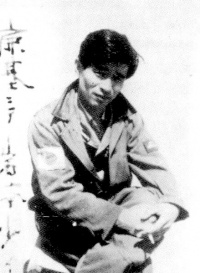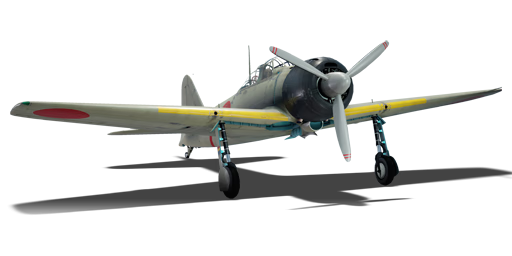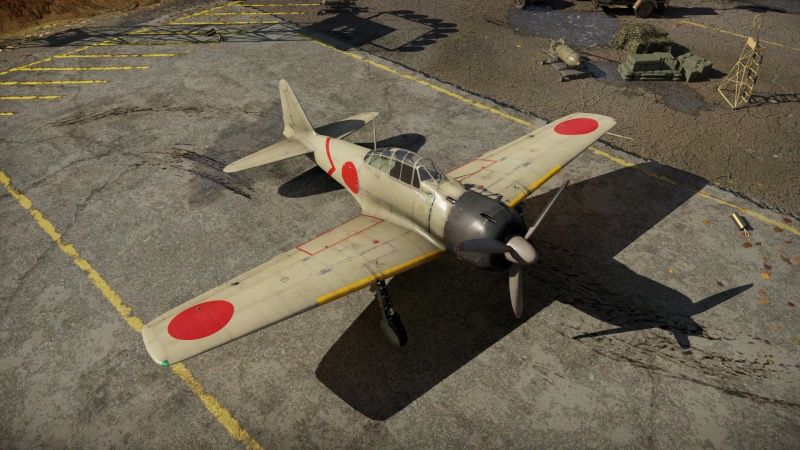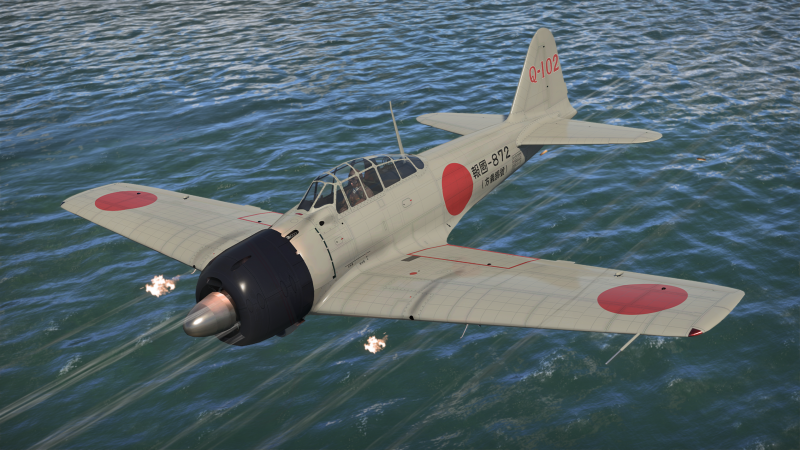Difference between revisions of "A6M3"
m |
Colok76286 (talk | contribs) (Edits) |
||
| Line 13: | Line 13: | ||
The '''{{Specs|pseudonym}} mod. 32''' is a rank {{Specs|rank}} Japanese fighter {{Battle-rating}}. It has been in the game since the start of the Open Beta Test prior to Update 1.27. | The '''{{Specs|pseudonym}} mod. 32''' is a rank {{Specs|rank}} Japanese fighter {{Battle-rating}}. It has been in the game since the start of the Open Beta Test prior to Update 1.27. | ||
| − | The first (major) improvement of the [[A6M]] series, comes with | + | The A6M3 mod. 32, first (major) improvement of the [[A6M]] series, comes with the new Sakae 21 engine, offering more power and high altitude performance with an added two-speed supercharger. Due to the engine being slightly heavier and longer it got shifted slightly closer to the cockpit with a new engine cowling and a slightly smaller main fuel tank. Next to engine changes, the Model 32 cuts down on the wing size to eliminate the need for folding wing tips. |
All of these changes offer a better roll rate, a higher diving speed of 670 km/h and only an increase in the max speed by 11 km/h. This comes at the cost of nearly 1,000 km less range and worse turning capabilities, the strengths of the [[A6M]] series. | All of these changes offer a better roll rate, a higher diving speed of 670 km/h and only an increase in the max speed by 11 km/h. This comes at the cost of nearly 1,000 km less range and worse turning capabilities, the strengths of the [[A6M]] series. | ||
Revision as of 08:53, 24 September 2022
| This page is about the Japanese fighter A6M3. For other versions, see A6M (Family). |
Contents
Description
The A6M3 mod. 32 is a rank III Japanese fighter with a battle rating of 4.3 (AB), 4.0 (RB), and 3.7 (SB). It has been in the game since the start of the Open Beta Test prior to Update 1.27.
The A6M3 mod. 32, first (major) improvement of the A6M series, comes with the new Sakae 21 engine, offering more power and high altitude performance with an added two-speed supercharger. Due to the engine being slightly heavier and longer it got shifted slightly closer to the cockpit with a new engine cowling and a slightly smaller main fuel tank. Next to engine changes, the Model 32 cuts down on the wing size to eliminate the need for folding wing tips.
All of these changes offer a better roll rate, a higher diving speed of 670 km/h and only an increase in the max speed by 11 km/h. This comes at the cost of nearly 1,000 km less range and worse turning capabilities, the strengths of the A6M series.
General info
Flight performance
As an upgrade of the already formidable A6M2 mod. 11, the A6M3 is not to be underestimated. Its clipped wings trade off some agility for extra dive speed (~40 km/h (25 mph) more) and a slightly faster roll rate. The extra 40 km/h provides a bit more freedom of engagement and acts as a surprise element as no one expects a Zero to be able to travel at ~700 km/h without ripping. This can come in handy when facing the Soviet Yak family since they compress and eventually rip slightly earlier than the A6M3. The nimble fighter also maintains its elevator authority until rather late in a dive (around the 550-600 km/h mark) and can withstand some serious wing load (14G at a time) which allows it to pull off risky manoeuvres and surprise opponents with very tight turns which can put it on their sixes in a matter of seconds. But all of this comes at the cost of massive energy bleeding so be wary of your surroundings when pulling such stunts. All in all its best use is as a turnfighter.
| Characteristics | Max Speed (km/h at 6,000 m) |
Max altitude (metres) |
Turn time (seconds) |
Rate of climb (metres/second) |
Take-off run (metres) | |||
|---|---|---|---|---|---|---|---|---|
| AB | RB | AB | RB | AB | RB | |||
| Stock | 537 | 522 | 10050 | 16.6 | 17.1 | 10.1 | 10.1 | 288 |
| Upgraded | 578 | 556 | 15.8 | 16.0 | 18.2 | 13.8 | ||
Details
| Features | ||||
|---|---|---|---|---|
| Combat flaps | Take-off flaps | Landing flaps | Air brakes | Arrestor gear |
| ✓ | ✓ | ✓ | X | ✓ |
| Limits | ||||||
|---|---|---|---|---|---|---|
| Wings (km/h) | Gear (km/h) | Flaps (km/h) | Max Static G | |||
| Combat | Take-off | Landing | + | - | ||
| 0 | 290 | 397 | 368 | 220 | ~15 | ~7 |
| Optimal velocities (km/h) | |||
|---|---|---|---|
| Ailerons | Rudder | Elevators | Radiator |
| < 280 | < 420 | < 410 | > 335 |
| Compressor (RB/SB) | ||
|---|---|---|
| Setting 1 | ||
| Optimal altitude | 100% Engine power | WEP Engine power |
| 1,850 m | 1,105 hp | 1,235 hp |
| Setting 2 | ||
| Optimal altitude | 100% Engine power | WEP Engine power |
| 5,000 m | 985 hp | 1,101 hp |
Survivability and armour
- No armour Protection
- No self-sealing fuel tanks
Modifications and economy
Armaments
Offensive armament
The A6M3 is armed with:
- 2 x 20 mm Type 99 Model 1 cannons, wing-mounted (100 rpg = 200 total)
- 2 x 7.7 mm Type 97 navy machine guns, nose-mounted (700 rpg = 1,400 total)
Suspended armament
The A6M3 can be outfitted with the following ordnance:
- Without load
- 2 x 60 kg Navy Type 97 Number 6 bombs (120 kg total)
Usage in battles
The Zero is a extremely effective dogfighter with a very tight turn. Head on engagements should not be taken with any plane, especially Americans such as the F6F and the P51, as the Zero is very fragile. Any hit can be lethal. The engine is very weak and fuel tanks can easily catch ablaze. At the start of the match, try climbing to be able to dive on unaware opponents. The plane can exceed 700 km/h allowing it to commit to very steep or long dives with slight stiffening. The biggest threats to the plane are American planes due to their potent and numerous guns, but any plane can be taken in a turn-fight victoriously.
In offence, aim to begin turn-fights with your opponents as you will outclass them, but take very careful shots. The guns are the weakest aspect of the plane and must be used with precision. Always aim for the fuel tanks or pilot as those are the most effective ways to take down enemy aircraft. Make sure to tail burning aircraft loosely as most fuel tanks are self-sealing. Bomber and other heavier planes should not be taken on as the guns are very ineffective. Only careful pilot snipes should be taken, otherwise conserve ammo for future engagements.
To defend yourself from the rear, perform a split S, which consists of rolling and turning downwards in the opposite direction, and turn to the enemy to begin engaging them. Planes will quickly overshoot and will have difficulty regaining dominance. If caught in a head-on situation, roll and dive downwards towards the enemy, make sure to have no commitment.
- In Simulator, the A6M Zero is overall a great plane to fly. Its advantages include the extremely smooth handling, impressive turn rate, low stall speed, the ability to not enter spins in extreme manoeuvres, decent rear visibility, and increased cannon ammo capacity. It is able to pull really tight turns or barrel rolls without losing control or going into a spin, allowing the player to use this stability to their advantage. Its disadvantages, however, are the fragile protection, wing-mounted guns, and the cockpit scattered with frames. Although not thick, these frames can still be obstructions in a fight. Also the gunsight is small and mounted very low, resulting in inadequate visibility over the nose. This can limit the player's ability to see the target in a turn fight since to lead the target, the player must cut inside its turn, meaning the nose will now block the target. The A6M can perform dogfighting, some ground pounding and some intercepting.
- You can bring the minimum amount of fuel (29 minutes) since this model of the Zero only has a 100-round drum per cannon, as a result you might need to constantly return to airfield to reload so there is no need to bring more fuel. Set the convergence to 150-300 m. When taking off, the A6M will shift severely to the left so it is best to set separate keybind for left and right brakes to counter the torque.
- For dogfighting, it is better to engage with an altitude advantage so climb to around 2,500 m. Track the opponent using lead or pure pursuit, as with lag pursuit you will eventually end up at the 6'o clock of the target aircraft whose fuselage will soak up most of your MG bullets, and your wing mounted cannons will become really awkward to aim. With the amazing stableness the aim should be easy. Target their wings or nose and avoid the back half of the fuselage as there is usually nothing in there. You can turn with most planes with your combat/takeoff flaps deployed. Note that it is best to fire in 10-round/one-second bursts to avoid wasting cannon rounds. Once the cannons are out, the leftover 7.7 mm MGs can only effectively damage single engine fighters.
- For ground pounding with bombs, look for tanks and pillboxes. First you need some separation between you and the target so you have enough time to line-up the drop. Dive at the target at a rather shallow angle, and release the 60 kg bombs when you are very close, with the target below the gunsight and filling up around half of it. If you only use the MGs, your targets are trucks, AAA and howitzers. Dive at it and stabilise the plane so the gunsight stays overall still at the target. Then, once the target fills out around 1/6 of the gunsight, open fire. If your aim is accurate you can destroy one target in a single pass. However, it is very recommended to set keybind for firing MG only as you can definitely not waste the valuable cannon rounds. Save them for any unexpected dogfights.
- Landing is easy thanks to the low stall speed and lovely handling. Line up and approach the airstrip at treetop, decrease speed to at most 210 km/h and deploy combat, takeoff and landing flaps in order. Further decelerate so the touchdown speed is no more than 180 km/h to avoid bouncing up. Keep braking until the plane reaches a full stop, you don't have to worry about the nose dipping down and causing a propeller strike.
Enemies worth noting:
- P-61: this plane is one tough nut to crack. It is quite fast, packs a fatal punch, has a searching radar, and a deadly turret on top. The turret consists of 4 x 12.7 mm M2 Browning machine guns that cover the upper half of the plane, and most P-61 players tend to fly low or get you into their upper half to target you with the turret. Avoid being above them at all costs, utilise the Zero's manoeuvrability and sneak under their belly. Its appearance resembles a P-38: a center fuselage with two engine nacelles extending backwards and forming the twin tail like a frame, you will know it is a Black Widow and not a Lightning when red tracer bullets start shooting out from it.
- I-16: the late I-16s are equipped with ShVAK cannons that can be pretty dangerous to your fragile airframe. They can turn equally well as the Zero, have superior roll rate but the stability is so terrible that as soon as they pull a little more on the stick, they will enter spins. Therefore it is quite easy to counter them: engage a turnfight with them and turn tighter and tighter, or do a few barrel rolls. They will quickly lose control and start spinning and it is quite hard to recover. Then simply get some separation, turn around and put some solid shots into them. They have an I-15's short and fat fuselage, a flat radial engine and triangular stabilisers located right after the low-mounted mono wings, all covered in olive green paint.
- F4U, F6F, P-47, etc: these planes are a huge threat to the late Zeros as they have superior firepower, speed, dive acceleration and robust airframes. Their 12.7 mm MGs can easily tear you apart or simply pilot-snipe you even when they are far away, as the M2 Brownings have great velocity and trajectory. They can also set you aflame easily. Start a turnfight whenever you see these stubby planes. The F4U has a long cylindrical nose and the iconic inverted gull wing. The P-47 has a huge, jug-like fuselage, bubble canopy and elliptical trailing edge that usually have invasion stripes painted on them. The F6F, on the other hand, might get confused with other planes as it looks rather average.
Manual Engine Control
| MEC elements | ||||||
|---|---|---|---|---|---|---|
| Mixer | Pitch | Radiator | Supercharger | Turbocharger | ||
| Oil | Water | Type | ||||
| Controllable | Controllable Not auto controlled |
Controllable Not auto controlled |
Controllable Not auto controlled |
Separate | Controllable 2 gears |
Not controllable |
Pros and cons
Pros:
- A6M for Carrier-based fighter:
- Strictly air-to-air role
- Gets 2 x Type 97 No.6 Land Bomb (60 kg), but strongly ill-advised for air battles
- Decent cannon armament
- Extremely manoeuvrable
- Excellent turn rate
- Excellent roll rate
- Very short takeoff distance
- Strictly air-to-air role
- Common Navy plane construction:
- Excellent manoeuvrability
- Nose-mounted armament
- Small radiator drag
- A6M3 model 32 specific:
- Clipped wings compared to average A6M model
- Slightly higher dive speed
- Slightly faster roll rate
- Clipped wings compared to average A6M model
Cons:
- A6M for Carrier-based fighter:
- Strictly air-to-air role
- Limited ammo
- Slow
- Low dive speed, and easily compressed in a dive
- Common Navy plane construction:
- Poor MG offensive armament: 7.7 mm Type 97 MG
- Poor Cannon offensive armament: 20 mm Type 99 Model 1 Cannon
- Very low muzzle velocity
- Fragile, little armour, and no self-sealing fuel tanks
- A6M3 model 32 specific:
- Clipped wings compared to average A6M model
- Slightly worse agility
- Clipped wings compared to average A6M model
History
In-game description
In April of 1942, a new A6M model fighter was launched. The main difference between the A6M3 model 32 and the A6M2 Model 21 was the new Sakae 21 engine (1130 hp), which had a two-stage supercharger making it more stable at higher altitudes and a propeller diameter of 3.05 m (150 mm greater than that of its predecessor). The engine was much heavier and longer than those used in previous models, so to prevent displacement of the center of gravity the engine was moved closer to the cockpit and the main fuel tank's capacity was reduced from 518 to 470 liters.
Also, the folding wingtips were removed, which increased the plane's dive speed limit but reduced its manoeuvrability and range. The latter side effect was particularly important as it made it impossible to use the A6M3 effectively during the 1942 campaign in the Solomon Islands. The 20 mm guns were replaced by Type 99-I model 3s, and their ammunition was increased to 100 rounds. Also, the aircraft could carry two 60 kg bombs.
A total of 343 A6M3 Model 32s were made for the Japanese navy.
Notable pilots
-
 Iwamoto flew sorties throughout the Pacific Theater in an A6M3.
Iwamoto flew sorties throughout the Pacific Theater in an A6M3.
Media
- Skins
See also
- Mitsubishi A6M2 (previous model)
- Mitsubishi A6M3 mod. 22 (following model)
- Aircraft of comparable role, configuration and era
- Grumman F4F Wildcat
- Nakajima Ki-43 Hayabusa (▃ Oscar)
- Supermarine Seafire
- Hawker Sea Hurricane
External links
| Mitsubishi Company (三菱商会) | |
|---|---|
| Fighters | A5M4 · Hagiri's A5M4 |
| A6M2 mod. 11 · A6M2 · A6M3 · A6M3 mod. 22 · A6M3 mod. 22Ko · A6M5 · A6M5 Ko · A6M5 otsu · A6M5 Hei · A6M6c | |
| A7M1 (NK9H) · A7M2 | |
| J2M2 · J2M3 · J2M4 Kai · J2M5 · J2M5 (30 mm) | |
| Hydroplanes | F1M2 |
| Interceptors | Ki-83 · Ki-109 |
| Bombers | G4M1 |
| Ki-21-Ia · Ki-21-I hei · Ki-67-I Ko · Ki-67-I otsu | |
| Jet Fighters | Ki-200 |
| Captured | ▃A6M2 · ␗A6M2 |
| See also | Mitsubishi Heavy Industries, Ltd. (Post-War) |
| Japan fighters | |
|---|---|
| Navy | |
| Carrier-based fighter | |
| A5M | A5M4 · Hagiri's A5M4 |
| A6M | A6M2 mod. 11 · A6M2 · A6M3 · A6M3 mod. 22 · A6M3 mod. 22Ko · A6M5 · A6M5 Ko · A6M5 otsu · A6M5 Hei · A6M6c |
| A7He | A7He1* |
| A7M | A7M1 (NK9H) · A7M2 |
| Land-based Fighter | |
| J2M | J2M2 · J2M3 · J2M4 Kai · J2M5 · J2M5 (30 mm) |
| J6K | J6K1 |
| J7W | J7W1 |
| N1K-J | N1K1-Ja · N1K2-J · N1K2-Ja |
| Fighter seaplane | |
| N1K | N1K1 |
| A6M-N | A6M2-N |
| Army | |
| Ki-10 | Ki-10-I · Ki-10-I C · Ki-10-II · Ki-10-II C |
| Ki-27 | Ki-27 otsu · Ki-27 otsu Tachiarai |
| Ki-43 | Ki-43-I · Ki-43-II · Ki-43-III otsu |
| Ki-44 | Ki-44-I · Ki-44-I 34 · Ki-44-II otsu · Ki-44-II hei |
| Ki-61 | Ki-61-I ko · Ki-61-I otsu · Ki-61-I hei · Tada's Ki-61-I hei · Ki-61-I tei · Ki-61-II Otsu Kai |
| Ki-84 | Ki-84 ko · Ki-84 otsu · Ki-84 hei |
| Ki-87 | Ki-87 |
| Ki-94 | Ki-94-II |
| Ki-100 | Ki-100 · Ki-100-II |
| Other countries | ▅F4U-1A · ▅P-51C-11-NT · ▅Bf 109 E-7 · ▅Fw 190 A-5 |
| *Imported designation of the He 112 (A6M was in development - A7M would take A7 designation after the cancelation of the A7He) | |






